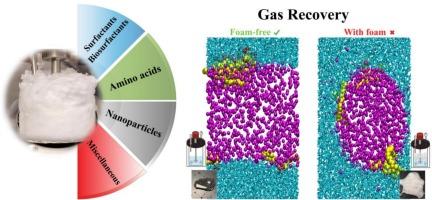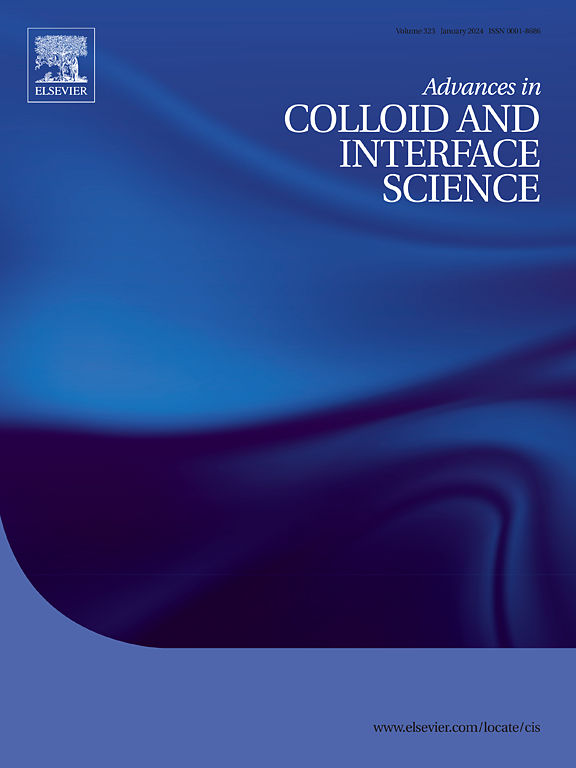Advances in solidified methane and carbon dioxide storage: The potential of amino acids, biosurfactants, and nanoparticles as foam-free gas hydrate promoters
IF 19.3
1区 化学
Q1 CHEMISTRY, PHYSICAL
引用次数: 0
Abstract
The rising global need for natural gas and the reduction of greenhouse gas emissions highlight the significance of innovative storage solutions like hydrate-based solidified gas technology. Gas hydrates offer great potential as an efficient and safe method for storing methane and carbon dioxide. However, it faces operational challenges, primarily due to foam formation during gas recovery, which adversely affects efficiency and increases operational costs. As the gas hydrates dissociate, they release significant volumes of gas into the surrounding water. Surfactants reduce the surface tension of this water, enabling the released gas to form stable bubbles encased in thin liquid films. This review highlights innovative approaches to developing foam-free promoters, specifically focusing on amino acids, biosurfactants, and nanoparticles that enhance hydrate formation while mitigating foaming issues. This review evaluates the mechanisms underlying these promoters' effectiveness, emphasizing their promotion power and foaming ability. Comparative analyses reveal that amino acids and biosurfactants enable rapid hydrate formation and effective gas storage under varied conditions, while nanoparticle systems provide structural stability and efficiency in complex environments. The performance of foam-free promoters is assessed under various conditions, including temperature, pressure, and salinity, revealing the importance of molecular mechanisms in promoting hydrate stability and efficiency. The potential of environmentally friendly materials, such as amino acids and biosurfactants, is emphasized, showcasing their effectiveness in reducing foam formation without compromising hydrate formation rates. Furthermore, their compatibility with renewable energy strategies aligns with global sustainability goals, making them pivotal for the commercial use of gas storage based on hydrates. The integration of advanced computational tools and systematic experimentation is advocated for optimizing promoter formulations, ultimately paving the way for the commercial viability of hydrate technologies. This synthesis of findings provides a comprehensive framework for future research and applications in the field of gas storage and recovery, underscoring the transformative potential of foam-free hydrate promoters in sustainable energy systems.

固化甲烷和二氧化碳储存的进展:氨基酸、生物表面活性剂和纳米颗粒作为无泡沫气体水合物促进剂的潜力
全球对天然气需求的不断增长和温室气体排放的减少凸显了创新存储解决方案的重要性,如基于水合物的固化气体技术。天然气水合物作为一种高效、安全的储存甲烷和二氧化碳的方法提供了巨大的潜力。然而,该方法也面临着运营方面的挑战,主要是由于在采气过程中形成泡沫,这对效率产生了不利影响,并增加了运营成本。当气体水合物解离时,它们会向周围的水中释放大量气体。表面活性剂降低了水的表面张力,使释放的气体形成包裹在薄液体薄膜中的稳定气泡。这篇综述强调了开发无泡沫促进剂的创新方法,特别是氨基酸、生物表面活性剂和纳米颗粒,它们可以促进水合物的形成,同时减轻泡沫问题。本文综述了这些促进剂的作用机制,重点介绍了它们的促进力和起泡能力。对比分析表明,氨基酸和生物表面活性剂能够在各种条件下快速形成水合物并有效储存气体,而纳米颗粒系统在复杂环境下提供结构稳定性和效率。对无泡沫促进剂在温度、压力和盐度等条件下的性能进行了评价,揭示了分子机制在促进水合物稳定性和效率方面的重要性。环境友好材料的潜力,如氨基酸和生物表面活性剂,被强调,展示了他们在不影响水合物形成速率的情况下减少泡沫形成的有效性。此外,它们与可再生能源战略的兼容性符合全球可持续发展目标,这对于基于水合物的天然气储存的商业应用至关重要。将先进的计算工具和系统的实验相结合,以优化促进剂配方,最终为水合物技术的商业可行性铺平道路。这一综合研究结果为未来在天然气储存和回收领域的研究和应用提供了一个全面的框架,强调了无泡沫水合物促进剂在可持续能源系统中的变革潜力。
本文章由计算机程序翻译,如有差异,请以英文原文为准。
求助全文
约1分钟内获得全文
求助全文
来源期刊
CiteScore
28.50
自引率
2.60%
发文量
175
审稿时长
31 days
期刊介绍:
"Advances in Colloid and Interface Science" is an international journal that focuses on experimental and theoretical developments in interfacial and colloidal phenomena. The journal covers a wide range of disciplines including biology, chemistry, physics, and technology.
The journal accepts review articles on any topic within the scope of colloid and interface science. These articles should provide an in-depth analysis of the subject matter, offering a critical review of the current state of the field. The author's informed opinion on the topic should also be included. The manuscript should compare and contrast ideas found in the reviewed literature and address the limitations of these ideas.
Typically, the articles published in this journal are written by recognized experts in the field.

 求助内容:
求助内容: 应助结果提醒方式:
应助结果提醒方式:


